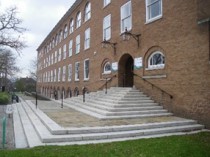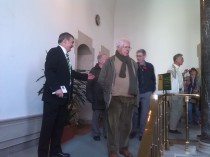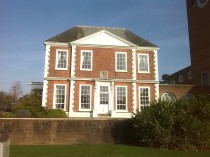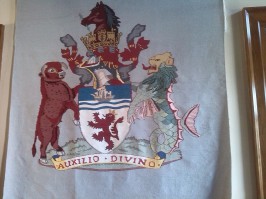
Exeter Local History Society Visit
The History of County Hall
23 January 2015
On a bitterly cold day our members started their visit with a look at the external architecture and its changes in style as building work progressed. Our attention was drawn to the unusually small specially-made bricks (we later learnt that the first builder went bankrupt because he had forgotten to quote for the extra mortar needed with such small bricks). The building was completed by others at a cost of £1.5 million, almost double the original estimate and it is today a remarkably artistic monument to the designer’s work.
Exeter was not considered a priority for re-building after WW2. This meant that, by the time re-building money came through from central government, more attractive building materials had become available. For instance, our attention was drawn to the elegant matching doors (some of which were false in the interests of symmetry!). County Hall is one of only 11 post-war buildings to be added to a list of buildings of special architectural or historic interest by the Dept. of Culture, Media and Sport. It was described then as “A major civic work by McMorran”, one of the most important architects to be working in a “sophisticated, neo-classical idiom” during the 1950s and 1960s.
The purchase by Devon County Council in 1950 of two adjoining estates, Coaver and Bellair, and the commissioning of the architect Donald McMorran in 1954, came just in time to save the listed building Bellair from collapse and demolition (although some say that Georgina Bullock was adamant that Bellair would only be sold “over my dead body” - but she died the night before the meeting to discuss the sale). Bellair is a fine example of domestic Georgian architecture and has been beautifully preserved.
We toured the County Hall offices and meeting rooms, noting the complicated and not very efficient hidden heating system, the varying styles of decoration in wood panelling and the cleverly arranged partition walls that allow a variety of arrangements of the overall room areas and we saw the rooms where Her Majesty the Queen was entertained on her first official visit, including the ‘royal bathroom’.
The most interesting and largest room inspected was the Council Chamber, which serves many functions including that of the Coroner’s Court. We learnt how the strict rules imposed by the ‘listing’ of the building seriously limit the use of modern electronics, while the complicated but clever engineering systems for raising and lowering lighting units for cleaning and bulb changing were clearly explained. Some of the history of the building has been preserved with interesting gifts and relics such as a very large tapestry and a ship’s bell with engraved signatures of famous people around its rim, though we had to assume a somewhat acrobatic posture to view them clearly.
Our visit finished with a brief look at what is left of the Coaver building’s original architecture, particularly its grand hall and staircase. This building is now an events hall and café where we had a very welcome coffee while applauding and thanking our guide, Charlie, formerly the Building Manager, for such an interesting tour.




